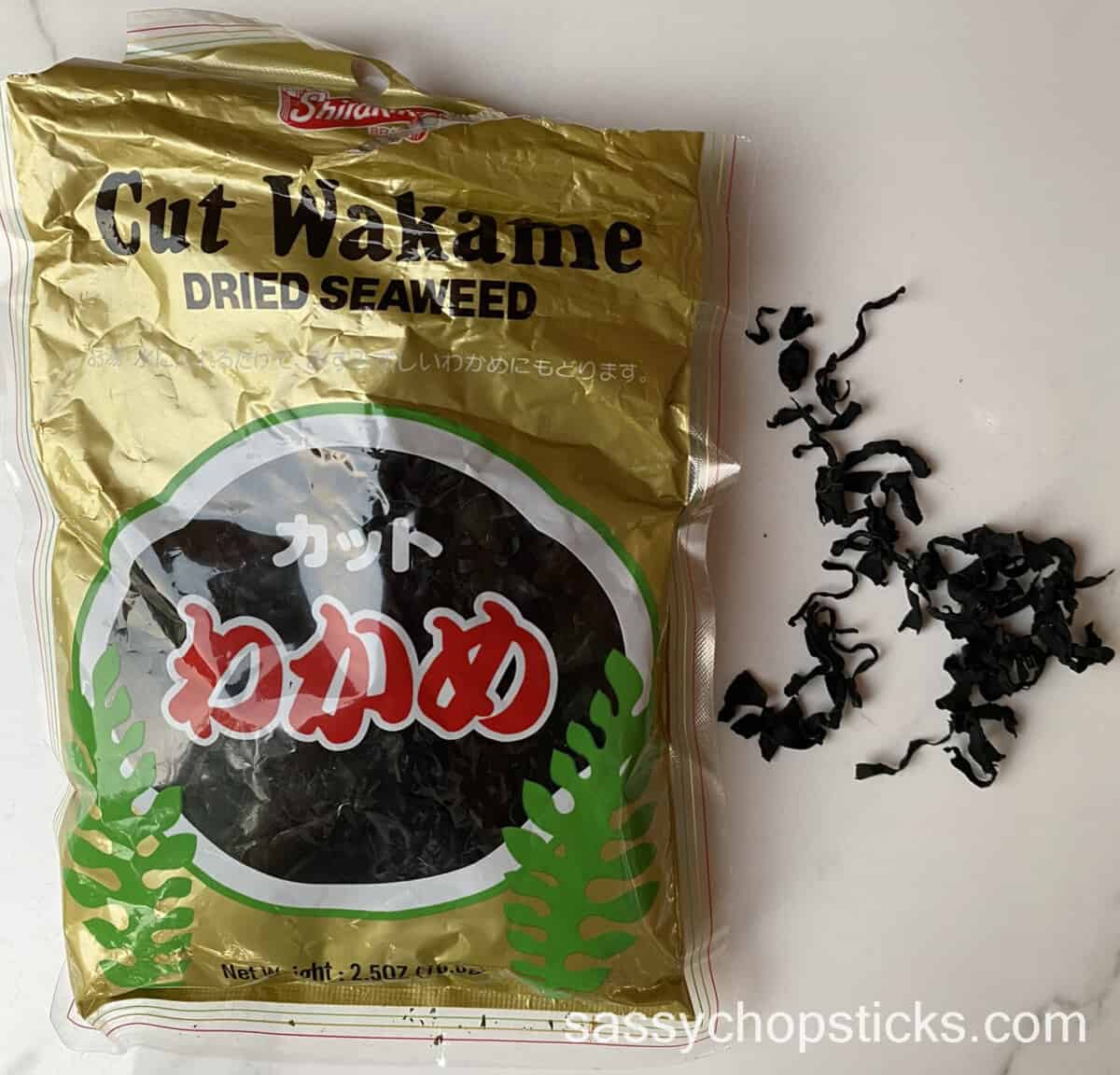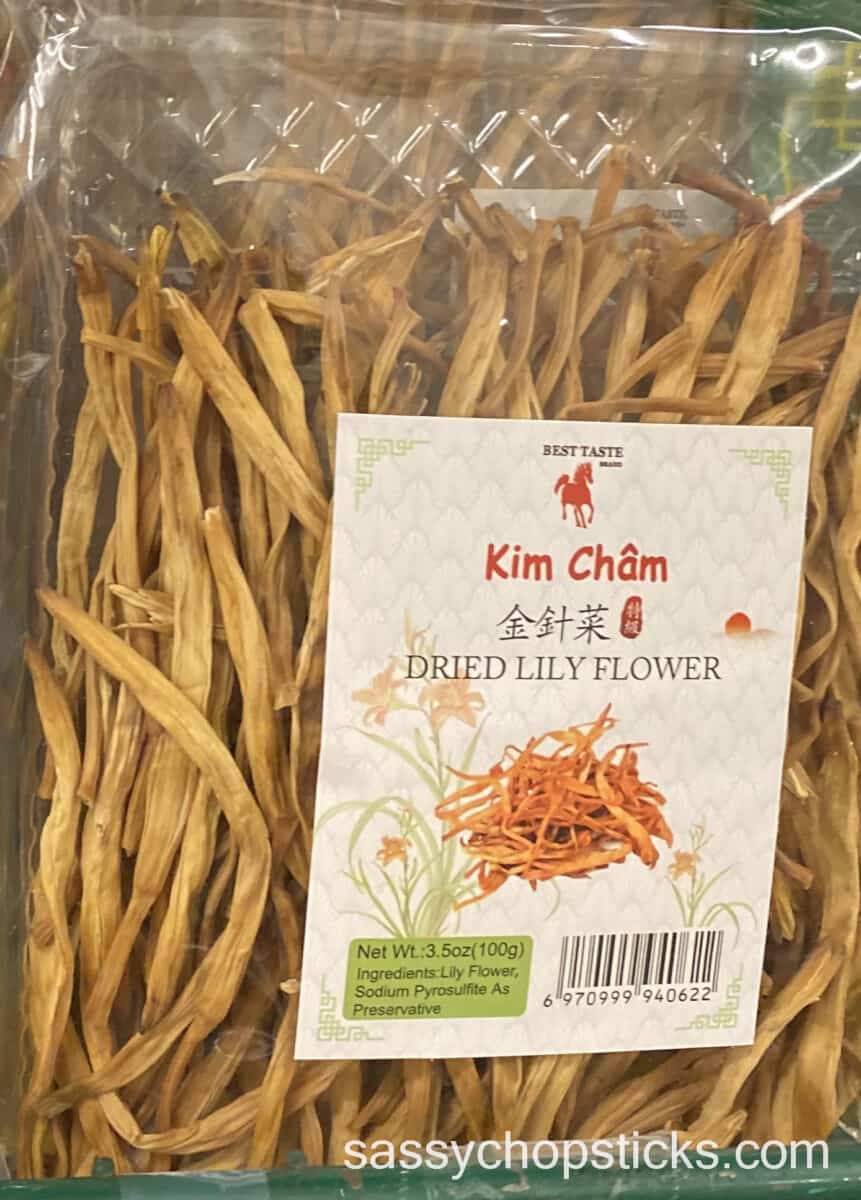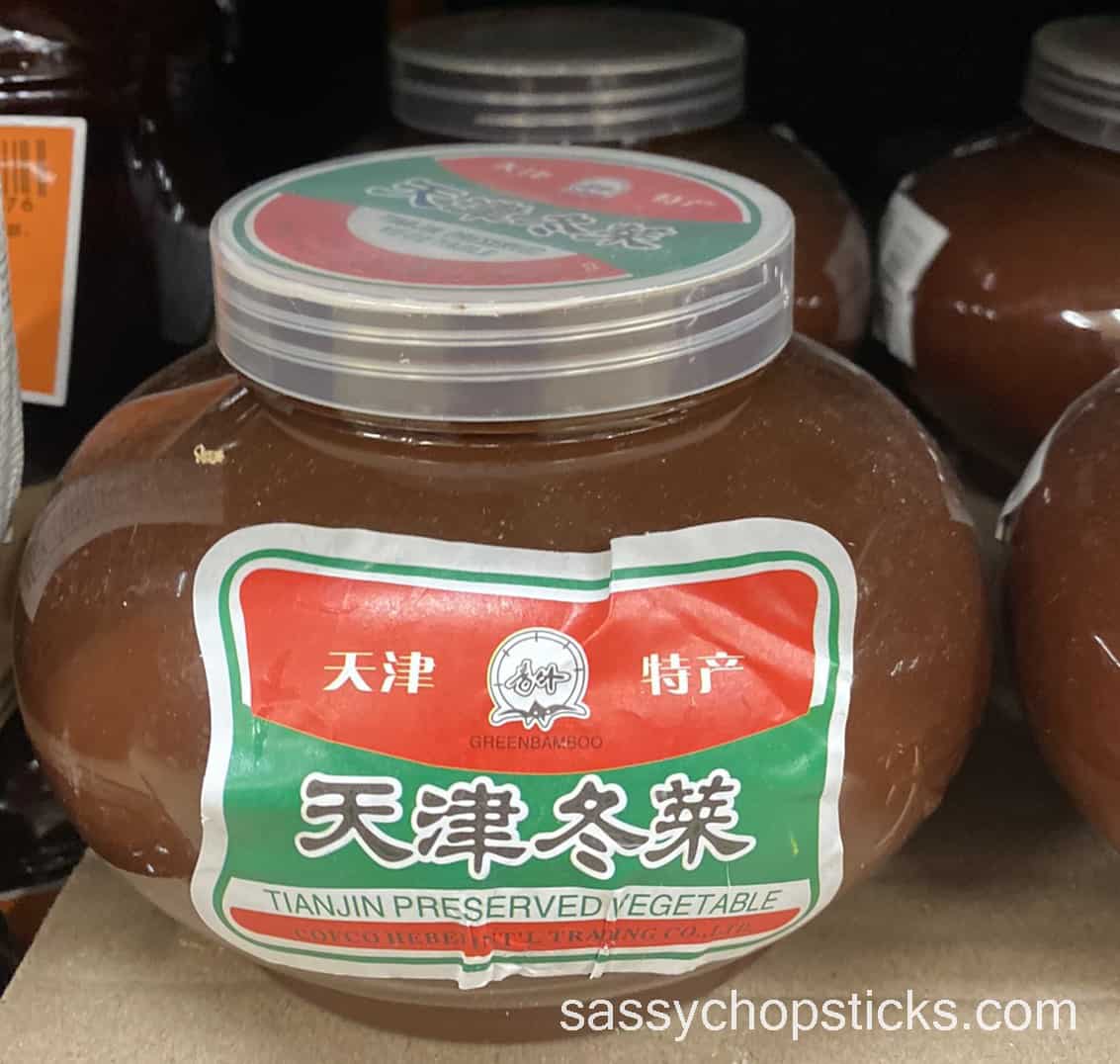Chinese dried and preserved ingredients has been a part of Asian culture for centuries. Salted and pickled ingredients are essential to the Chinese pantry. For over a thousand years, the Chinese have dried or preserved food as a method of extending shelf life, which gave them the opportunity to have various foods longer for the winter months. Much like the spices in Western culture, dried ingredients not only add texture to the dish, but they add deep flavors to the food. You will find that the Chinese favor the taste and texture of a dish over mere nutritional value, and they are great at creating dishes that have umami, or a savory taste.
Chinese pork sausage (香肠)

Chinese sausage or wind-dried pork sausage is a seasoned, semi-dried sausage. It is made from fatty pork, and this gives it a rich flavor. It is dried, so it must be cooked before eating. It can be fried, served with wilted greens, steamed with rice, or served in lettuce wraps. Dried sausages are used in sticky rice or wrapped in a lotus leaf and steamed. They also go well with chicken.
Chinese preserved mustard greens (酸菜Suān Cài)

You will rarely sit at a Chinese dinner table without leafy greens being served. The Chinese mustard greens, also called leaf mustard or mustard cabbage, includes a variety of leafy greens mustard that are salted, pickled, or preserved. While very healthy, they are also bitter and are usually cooked with sugar and ginger. In fact, Chinese elders have a saying “If it’s bitter, then it’s probably good for you.” However, because they are naturally very salty, soaking and washing them before cooking is necessary. Chinese pickled mustard greens stir fry is definitely one of the dishes I recommend you try!
Dried shrimp(干虾)/scallop(干贝干)

In everyday Chinese cooking, dried shrimp and scallops are used to give a rich taste to bland foods like tofu or some vegetables. Dried scallops come in various sizes and colors. They are often cooked with fish maw or winter melon or added to fried rice. Dried shrimp also comes in varying sizes. They are used for their salty flavor to add to soup or stir-fry. Dried shrimp and scallops give dishes a very savory, or umami taste.
Chinese Dry mushroom (香菇)

The Chinese favor dried mushrooms over fresh ones because the drying process enhances the mushrooms’ flavor. This is one of the most common used Chinese dried and preserved ingredients. There are many varieties of mushrooms, which range from light brown to dark brown, or smooth to flowery patterned. Black mushrooms are a staple in Chinese households. The flavor and fragrance are stronger than you’d find with a fresh mushroom, and this is what gives dishes a meaty flavor. They enhance any soup, stir-fry, or braised dish they are added to. They also absorb the sauce or broth they are being cooked in, making the mushrooms even more delicious.
Dry seaweed(海带)

The Chinese have been using dried seaweed for centuries. It is stocked full of health benefits, including helping thyroid function, diabetes, gut health, weight loss, and may even benefit heart health. It is added to dishes for texture, flavor, and nutrition. You may find dried seaweed in egg drop soup, salads, or braised pork, where the seaweed gives the sauce a rich flavor. Seaweed has a salty flavor and an al-dente texture. When cooked, it takes on the flavor of the seasonings added to it, making it a very versatile food staple. Dry seaweed is also widely used in wonton soup.
Black fungus(黑木耳)/white fungus (white cloud ear,银耳)

In Chinese dishes, it is common for black or white fungus to be used for medicinal purposes. It can be used in soups to help soothe a cough, heal the lungs, or for nourishment. Black fungus is a wild mushroom that is also known as tree ear or cloud ear fungus because it is shaped like an ear. Black fungus is high in fiber and anticoagulant substances and may promote blood circulation, improve anemia, and stimulate the bowels. It has also been used to treat jaundice and sore throats. Black fungus has a neutral taste and easily takes on flavors of the spices or sauces it is being cooked with.
White fungus, also known as snow fungus, white cloud ear, or snow ear, grows on tree bark and branches. It has been used for centuries for its anti-inflammatory and antioxidant effects. It has a white or pale-yellow color and an almost-translucent, jelly-like texture.
Dried Lotus leaves(粽子叶)


Zongzi(粽子) is a glutinous rice dish wrapped in bamboo or lotus leaves with a sweet or savory filling.
Bamboo/Lotus leaves are a major component of Chinese rice dumplings (zong zi,粽子), as they keep the rice dumpling moist and tucked. Dried bamboo/lotus leave has a natural plant fragrance smell.
Dried tangerine peel (陈皮)

Known as Chenpi, dried tangerine peel is tangerine that is preserved by storing it dry. It first gives a slightly sweet taste, but afterward, the taste is bitter. In Chinese cooking, dried mandarin orange peel is used in savory dishes made from beef, chicken, or fish. It is also used in dishes like red bean soup or orange chicken. The rinds can also be simmered and used to flavor meat, and dried peel can be used to add a citrus fragrance and a fruity flavor to herbal tea. This is one of the Chinese dried and preserved ingredients you can make on your own at home.
Century egg (皮蛋)

Century eggs are preserved eggs that are used in Chinese cuisine. They are made by preserving chicken or duck eggs. During the preservation process, the yolk becomes green or gray and has a creamy consistency. The egg white becomes a translucent brown jelly with a salty flavor. Century eggs can be eaten by peeling and rinsing them. They have eaten alone or as a cold side dish. Or even added in the porridge.
Preserved salted radish (萝卜干)
This preserved vegetable is almost always found in a Chinese pantry. A staple side dish, salted radish has a sweet and sour taste and a crunchy texture. It can be served as a side dish to starchy dishes and is also used in sushi rolls, omelets, stir-fry, soups, and omelets. It is made with white radish and is full of vitamin C, potassium, and folate, not to mention fiber. And it adds that umami flavor traditional Chinese dishes are known for, not to mention the texture it adds to the dish.
Five-spice Powder(五香粉)


Five-spice powder is a blend of ground spices that is used to flavor braised or roasted meat, fish, or poultry dishes. It can also be used in marinades. It is believed that spices encourage harmony by uniting the five flavors seen in Chinese food, which are sweet, sour, bitter, salty, and pungent. The spices are also rich in antioxidants and are a great source of copper, manganese, and iron.
Dried lily flower (黄花菜)

The dry lily flower is one of the most notable edible flowers in Chinese cuisine, dried lily buds are used as both food and medicine. Cooked dry lily flower has a mild chestnut flavor, they are often commonly used in soup or stir fry.
Salty fish (咸鱼)


Chinese salted fish is a Cantonese classic. In the early days, the people of the south faced the sea and had an excellent supply of fish. So, they began salting and drying fish they caught to preserve them for future use. You can often see lots of salty fish dishes in the south of China. Salted fish fried rice is one of the most popular ones.
Star Anise (八角)

Star anise grows in China, Indo-China, and Japan, and is also known as Chinese star anise. Among the main flavors of Chinese five-spice powder, it is one of the most prominent. Roast duck and other meat are also made with it by the Chinese people. Typically, it is used in Western cultures as a flavoring for liqueurs and to flavor baked goods like cookies and cakes.
Kao Fu(烤麸) – Spongy Gluten

This ingredient is also known as braised wheat gluten. It serves as a substitute for meat for vegans or persons off meat. It tastes and has the appearance of tofu but has a spongier feel. It is made from wheat gluten and water. The mixture is first leavened and then baked or steamed which makes up for its spongy texture and many air pockets.
Salted Duck Egg (咸鸭蛋)

The primary component of the salted duck egg is the duck egg. It is made from soaking duck egg in brine, or salted charcoal. The process of salting the duck eggs gives them a briny aroma. The outer white part is firm and has a gelatin grip; of course, it is averagely salty. But the orange-red yolk is less salty, and it serves as an inclusion in the Chinese mooncakes where it is used to symbolize the sun.
Dried lotus seeds (莲子)

Lotus seeds or lotus nuts come from an aquatic plant. The two types of this ingredient are the elite peel and the brown peel: the difference being a result of the time of harvesting. The common use of the lotus seed is in preparing the lotus seed paste. It can also be blended into powder and used in bread making. And they can be popped raw.
Sichuan Peppercorns(花椒)

This spice is one of the five-spice-power spices. It comes from the reddish-pink berries of the prickly ash tree, with small dark seeds. It smells like lavender but to the mouth, the first taste is seemingly bitter. This bitter feeling is quickly followed by numbing heat, then citrus. It is most times ground to powder and included in the dish but could be used whole. You can them a lot in Sichuan cuisine.
Water Chestnut (马蹄)


This ingredient comes from an aquatic tuber that grows in freshwater marshes. It is used in conjunction with other vegetables in dishes like stir fry. They are included in the dishes by slicing them into desired pieces. They have a fruity taste and appearance. It has the texture of a pear and tastes both like an apple and a coconut.
Tianjin Preserved Vegetable (Dong Cai,天津冬菜)

This vegetable comes from a thinner and more slender kind of Napa cabbage native to the Tianjin region. The Tianjin cabbage comes with a salty taste and is usually consumed in relatively small quantities and with a little seasoning. It is added in bits in soups, stir-fries, and stews.
Pork Floss(猪肉松)

This is a dried meat product. Pork floss is made by cooking the pork shoulder in soy sauce and sugar, after which it is shredded until it takes on a fine texture. Seeing as the major component of pork floss is pork, it has a sweet pork jerky flavor, and it is enjoyed as a side dish or as a brief snack. I ate this a lot when I was little, pork floss is fluffy and delicious. It is a perfect side dish for congee.
Dried Bean Curd (腐竹)

Dried bean curd is an offshoot of bean curds, the only difference is that in this case it is dried. The primary component of the bean curd is coagulated soy milk. The bean curd skin is dried and then pressed into sheets till further use. It tastes just like soy milk or tofu and serves as a great inclusion to different dishes. Dried bean curd is a top choice for vegans and vegetarians. They are my favorite Chinese dried and preserved ingredients.
Dried Red Chili Pepper (干辣椒)

Chinese dried red chili pepper is extremely hot. It has a sharp, bright flavor that's tinged with slight acidity and is quite spicy. In Asian grocery stores, they are normally sold as the whole one. Chinese dried chili peppers are widely used in Chinese cooking, like the well-known dish Kung Pao Chicken.
Zha Cai(榨菜)

Zha Cai is a type of preserved mustard plant stem. It tastes salty, sour, and a little bit spicy. This preserved vegetable may have a humble appearance, but a tiny bite reveals its powerful flavor, as well as the addictive texture.
Check out a few more interesting Chinese dried and preserved ingredients listed here: Chinese Herbs and Benefits.
Bottom line
It is no surprise why Chinese food is rich in flavor, color, taste, and health benefits. With all the great Chinese dried and preserved ingredients, they add to their dishes, the incredible flavor is added and then mixed with other flavors to create that umami taste they are known for. These are just a few pantry staples they use to accomplish that. Explore Chinese cuisine for yourself and get to know the different dried goods they use and how they can add flavor to the various Chinese dishes you already enjoy.


















Leave a Reply